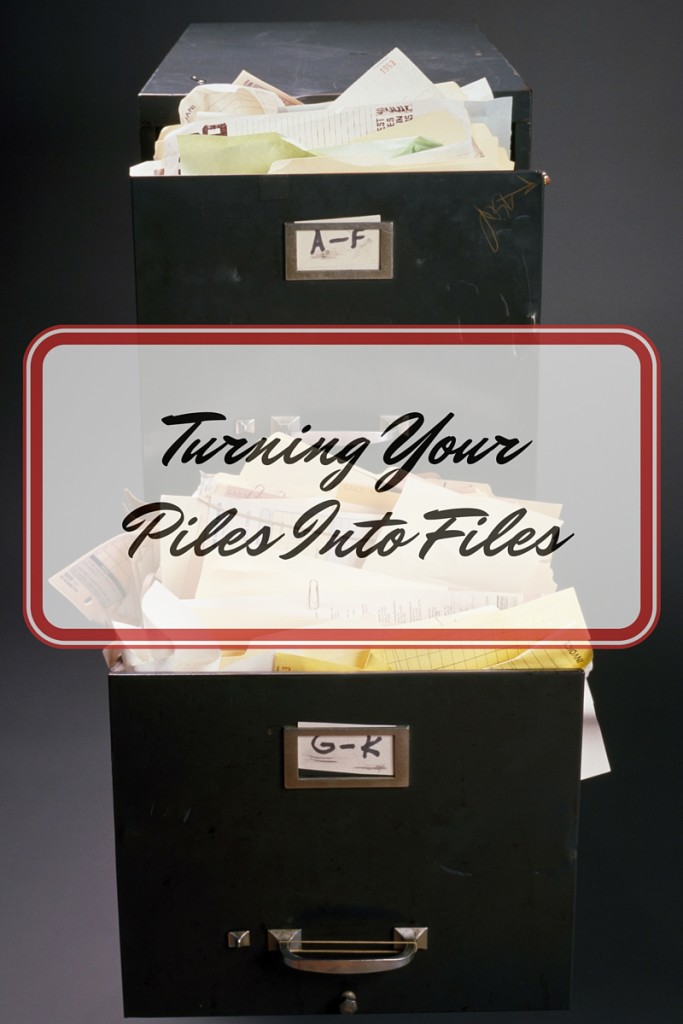Some days it seems every piece of paper that enters our home multiplies! What started out as a few pieces of junk mail turns into a never-ending stack of paperwork to be sorted and handled. To be very honest with you, paper management has caused a lot of stress and headaches for me over the years. I can remember being told about a decade ago that we were headed to a paperless society and that home files would be a thing of the past. It might still happen someday, but for now we still have to handle daily mail and important records for our home and family. I’ve tried several organizational strategies for storing papers and finally settled on a simple and accessible filing system that really works for me. Take these steps and turn your paper piles into organized files!
Turning Your Piles Into Files
Step 1 – Gather Papers & Materials Needed
This would include any paperwork you need to keep or handle. Get file folders and labels that fit your file drawer or box. If you have a label maker this would be a great time to put it into use. At this point you will decide what type of filing system you would like to have. A detailed person wouldn’t mind many categories and sub-categories, while a big picture person will have fewer categories. You must create a file system that you can maintain easily or it won’t work.
Step 2 – Sort Your Papers
Sort your papers into stacks of similar items. For example, personal documents such as birth certificates, your marriage license, personal wills, etc., should all go into one pile. Sorting these papers will make it easier to decide what categories will need to be included in your filing system. This is the time to purge unnecessary papers and dispose of outdated and expired items.
Step 3 – Decide File Categories to Include
When sorting your papers you will have already gotten ahead on this step.
Here are some category titles and items to include:
Auto – title, repairs, service records
Budget – monthly and yearly budgets, bills already paid and needed receipts
Career – resumes, accomplishments, certifications and business licenses
Correspondence – personal letters and cards
Education – educational records, report cards, diplomas
Financial – bank statements, credit card information, mortgage and real estate paperwork, utilities, investments
Household – appliance and service warranties, repairs, ongoing care contracts, household inventory
Insurance – all policies including auto, medical, dental, vision, life, home or renters insurance
Medical – dental and medical records, immunization charts and healthcare expenses for each family member
Taxes – donations, pay stubs, important receipts and expense records
Vital Documents – birth certificates, marriage certificate, driver’s license information, Social Security information, passports, TSA Pre-Check verification letters, adoption records, death certificates, military records, power of attorney and personal wills
Step 4 – Label Your Folders & File Your Documents
Once all of your paperwork is filed, throw away the trash and shred any documents with personal information included. Identify theft is at an all time high. Protect yourself and make sure none of your personal information is exposed.
Step 5 – Create a Daily Rotation File
Everyday new papers come into your home. The mail arrives, kids bring home papers from school, invitations and receipts – all of these paper items need to be handled daily or they will pile up again. Before you know it, you will have another huge task to handle. While it might seem a waste of time, take a few minutes and handle these item as they arrive each day. Those few minutes each evening will prevent a major project in the future. To handle these items, you will need to set up a Daily Rotation File. You will need to have an accordion file with at least 8 sections.
You can adjust these categories to fit your needs, but they should include:
To Do – invitations to respond to, appointments to schedule, calls to make
To File – this is the temporary holding place for items that need to be filed in the master filing system
To Pay – when you pay your bills, handle these items and then file in the master filing system
To Read – newsletters, magazines, correspondence
Fun – coupons, gift cards & certificates, take-out menus
Receipts – those needed for budgeting purposes or possible returns
School – calendar, projects, schedule, activities & program announcements
Urgent – items to be handled immediately
Step 6 – Implement Your Plan
If you are going to take the time to set up a terrific filing system for your paperwork, you must have a daily strategy to follow through and manage your documents. Don’t fall back on a mail basket and throw everything in it until you have time. It just won’t work and you will miss appointments, pay bills late and be unprepared for scheduled activities. Plan 10 minutes each day to handle all incoming mail and paperwork.
Taking time to set up a home filing system and creating a plan for handling all of that incoming paper can declutter your home, alleviate daily stress and equip you to handle life more efficiently!
